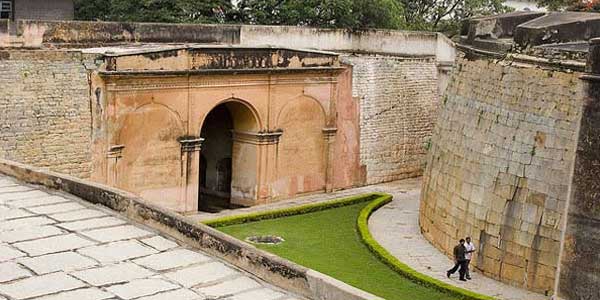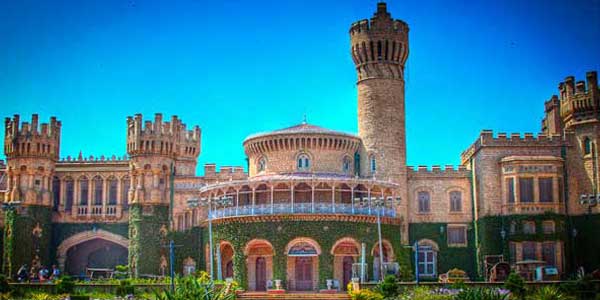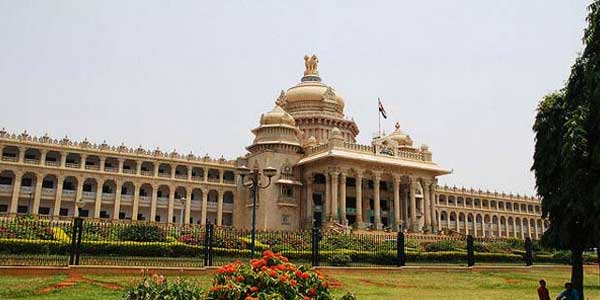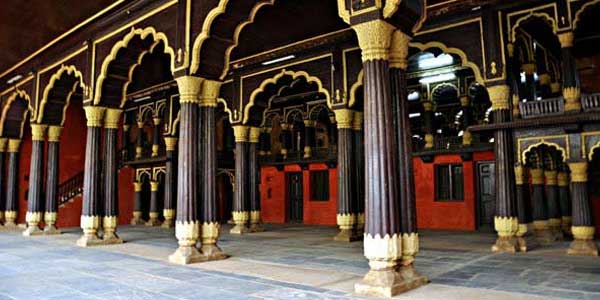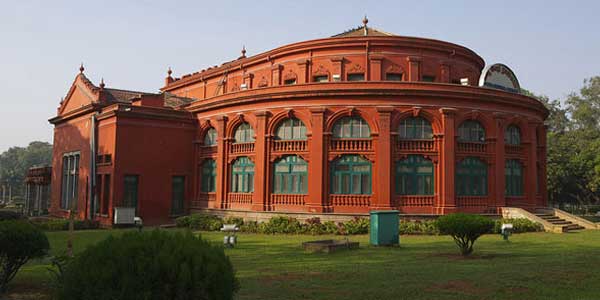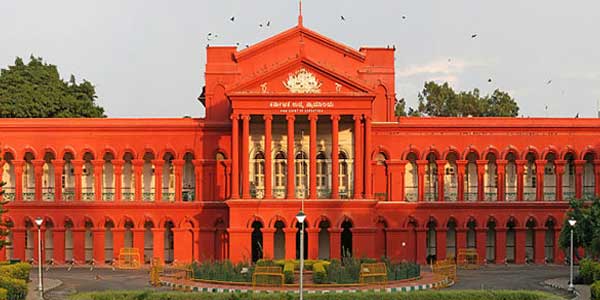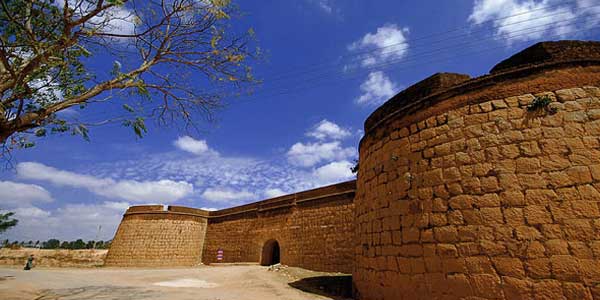
Bangalore Fort
'Bangalore Fort' is actually a tiny remain - rather a gateway portion - of an otherwise sprawling fort that stood as the prime landmark in the old days Bangalore. By the way this is located around the KR Market area in the city. Get down at City Market bus stop and walk to the fort. There is a ticket counter at the gate.
The history line goes like this. Some 500 years back, the region was ruled by a feudatory of the Vijaynagar Empire. Kempe Gowda, a chieftain of Yelahanka is often attributed as the founder of the old Bangalore city. He built a mud fort around the then Bangalore. This settlement grown steadily into a town and later into a city.
The turbulent part of the region starts after the fall of the Vijayanagara Empire, that ruled most of south India. So was the fortunes of the Bangalore Fort. In 1638 the Bijapur Sultan's army along the ambitious Maratha general Shahji Bhonsle ( father of the more famous Shivaji ) defeated the ruler Kempe Gowda III. Bangalore was given to Shahaji as a jagir( grant ).
Some 5 decades later the Mughal general Qasim Khan captured Bangalore from Venkoji (son of Shahaji ) and made it as a part of the Sira province of the Mughal empire under Aurangzeb. Subsequently Bangalore was 'sold' to the Mysore king Chikka Devaraja Wodeyar in 1687 for a sum of 3 lakh rupees!
Under the Mysore kings there were some attempts to modernise the mud fort and its environs. Most notable of the king's additions is the Kote Venkataramanaswamy temple located adjacent to the Tipu Sultans palace.
But the fort what you see now was largely built by Hyder Ali (in 1761), the Commander-in-Chief of the Mysore Army, who later became the ruler of Mysore. He also started the construction of a palace , now popularly called the Tipu Sultans Palace. The modernization work of the Bangalore Fort is attributed of Ibrahim Sahib one of the Khiledar ( commandant ) of Hyder Ali's forces.
At many places in fort you can see the evidences of retrofits and improvisation of an existing fort. See the images for some of the examples.
Bangalore Fort was in the thick of military actions later during the regime of the famous Tipu Sultan. The third Mysore War ( between Mysore Kingdom and the British East India Company) saw the breach of Bangalore Fort in 1791.
On 7 February 1791, Cornwallis captured Bangalore by assault and a siege of the Bangalore Fort ensued.On 21 February 1971, after six weeks of siege, the East India Company's forces stormed the fort.That marked the beginning of Tipu's fall.
Mark Wilks, the later Resident of Mysore (who made first hand account of the Mysore Wars) wrote this narrative on the siege of Bangalore Fort:
" It was bright moonlight eleven was the hour appointed, and a whisper along the ranks was the signal appointed for advancing in profound silence; the ladders were nearly planted, not only to ascend the faussebray but the projecting work on the right, before the garrison took the alarm ; and just as the serious struggle commenced on the breach, a narrow and circuitous way along a thin shattered wall had led a few men to the rampart on the left flank of its defenders, where they coolly halted to accumulate their numbers till sufficient to charge with the bayonet. The gallantry of the killedar, who was in an instant at his post, protracted the obstinacy of resistance until he fell ; but the energy of the assailants in front and flank at length prevailed.
Once established on the ramparts, the flank companies proceeded as told off, by alternate companies to the right and left where the resistance was everywhere respectable, until they met over the Mysore Gate : separate columns then descended into the body of the place ; and at the expiration of an hour all opposition had ceased.
" On ascending the breach, a heavy column was observed on the left, advancing from the embankment designed to attack the assailants in flank and rear ; but this also had been foreseen and provided for, and they were repulsed with great slaughter by the troops reserved for that special purpose ; a similar column, lodged in the covered way on the right, had been dispersed at the commencement of the assault by a body appointed to scour it and draw off the enemy's attention from the breach ; and at the moment the flank companies had met over the Mysore Gate, another column was perceived advancing along the sortie. to enter and reinforce the garrison ; but a few shot from the guns on the ramparts announced that the place had changed masters. The carnage had been severe but unavoidable, particularly in the pressure of the fugitives at the Mysore Gate, which at length was completely choked."
As part of the peace treaty ( Treaty of Seringapatam ) Bangalore Fort was restored to Tipu's control, though much of his kingdom and powers were curtailed. For some reasons Tipu dismantled a large portion of the fort. By now the Bangalore Fort had lost its military significance.
Then came the fourth and final Mysore War. The action shifted to Tipu's capital Srirangapatna, located near Mysore city. In 1799 Tipu Sultan was killed in that battle.
In the mean time ( by 1802 ) Purnaiya , the Diwan of Tipu and later the Prime Minister of Mysore under the British repaired the Bangalore Fort to some extend.
Srirangapatna Fort became the garrison of the occupying forces. In 1811 the British moved their garrison from Srirangapatna to Bangalore. The fort was converted into the quarters for the troops. Later in 1823 the artillery arsenal too was transferred from Srirangapatna to the Bangalore Fort.
in 1823
In 1831 the British assumed direct administration of Mysore and most of the buildings that were part of the fort were converted into public offices, including the Tipu Sultan Palace. The fort remained as a military store of the British for long. This became their main ammunition supply store for troops located outside Bangalore.
Also the British built command hospitals around the fort area. The legacy continued, you can see a large number of hospitals around the fort locality including the Bangalore Medical college, Victoria Hospital, Minto Eye Hospital all are in someway part of Bangalore's heritage too.
By 1868 new administrative offices ( Attara Kacheri ,the present day High Court building) were constructed around the cantonment area. Most of the public offices were moved out, but the arsenal depot.
In 1884 there was a move to clear of the remains of the fort (probably to make a road or other new buildings). That was dropped thanks to the public opinion of the resident community and also by the wishes of the then Mysore Maharaja.
On 2nd October 1888 the garrison was vacated and the Bangalore Fort was handed over to the civil administration authorities.
In any case a large parts of the fort walls were removed for development works. Earlier the road has to take a zigzag route through the many fort walls. Later for the sake of convenience the road was straightened by demolishing some parts of the wall. The present day Victoria Hospital (constructed in 1900), Minto Eye Hospital (1913 ) marks the walls of the original Bangalore Fort.
The first thing you notice as you reach the Bangalore Fort is the circular bastion that projects on to the road. The visitors entrance (9 AM to 6 PM) is just around this bastion. You can see the signboard by ASI and a small garden in front of visitors entrance. Once inside the compound, a giant archway gives access to the inside of the fort. This is The Delhi Gate.
Originally the fort stood at the edge of the Petta (town). The Delhi Gate was facing the town. Now having the town grown all around the fort, and most of the fort missing, you can not easily figure out its original strategic intent.
The Delhi Gate portion is a fine specimen of Islamic military architecture with the characteristic arches , motifs and the lattice work. The exterior of the arch is beautifully decorated with motifs. As you go through the gateway , on either sides you can see the lattice windows pierced on stone sheets. Then stands a pair of gigantic wooden doors with rows of metal spikes on it. The spikes are basically a deterrent against charging elephants, that was a military technique used in those days to break open fort gates. The door is kept is a semi opened position, so just go behind it to see the spikes.
After crossing this gateway structure, you will enter an open court surrounded by the tall fort walls. The most prominent thing you will notice in the open court is a shrine facing the gateway that your have just crossed. This shrine of Ganapati dates back to the original mud fort Kempe Gowda built in the 16th century. In fact he made two shrines , one for Ganapati (for fortune) and the other for Hanuman ( for strength). You will notice that the temple is located along a fort wall, which was actually a gateway. This gateway was later closed by Tipu as part of the improvisations. A gateway at this point gave a straight line access to the interior of the fort. So another wall erected and a 90 degree turn is required to enter the second gateway. In this improvisation the probably had concealed Hanuman shrine.
The Ganapati shrine which occupies the prime point of the court is notable for its style. It is style unusual to the region with sloping pyramid like roof and whitewashed plane walls. At first sight it appears more of an old house. Right in front of the temple , on a granite platform is image of a mouse , the mount of Ganapati. The original shrine would have undergone many additions to reach in its present form. You can easily notice arbitrarily placed friezes on the base of the shrine.
Also on the frieze above the roof has the Gandaberunda (two-headed bird) icon, the coat of arms of the Mysore Kingdom. At the corner of the Ganapati shrine and the fort wall is a tiny shrine of Krishna.
In this court, on the wall you can see many smaller doors with beautifully decorated lintels. The decorations and motifs are mostly in the Hindu style.
After the Ganapati Shrine you'll take a left turn to get out of the open court. Now you will go through another large gateway, but without any wooden doors.
Now you are on a sprawling open space , which is now converted into a lawn. All around you is tall fort walls with some openings. You can practically go around the lawn to see the details. At one point a circular bastion projects into this sprawling court.
During the functional days of the fort, canons were mounted over the bastion to fire at the invading army from this vantage position. Close to this bastion is another giant gateway (now kept closed). Beyond witch was the inner compound of the fort. All of when is lost and now occupied by roads and other civil structures.
Between this bastion and the gateway just mentioned is a well.
One of the historic hilights of Bangalore Fort is a the cell where Caption David Baird ( later Sir David Baird) and was imprisoned by Tipu.
The Battel of Pollilur ( near Kanchipuram) in 1780 saw the worst defeat of the Company forces. Caption David Baird along with host of other English troops where captured as prisoners by the Tipu's forces. Before releasing from the jail ( called the Dungeon of Baillie ) in Srirangapatna where he was held for close to 5 years , Caption David Baird was brought to Bangalore and kept in a cell in the Bangalore Fort. He was released in 1785 as part of the peace treaty. Twenty years later, in 1799, he ( as Major General ) led the British troops in that decisive battle that stormed Srirangapatna.
A plaque over a the cell in Bangalore Fort reads, "ln this Dungeon were confined Captain (afterwards Sir) David Baird and many others prior to their release in March 1785 "
Apart from the Delhi Gate, what you can see as the remain of the Bangalore Fort is the ammunition store of Tipu. This is now in a much dilapidated condition.
Bangalore Monuments
Bangalore Monuments, if you go by popular accounts, is the Silicon Valley and the Garden City of India. Heritage and culture have always flown freely in the veins of Bengaluru along with contemporary significance. The historical monuments of Bengaluru unfold a whole new world of historical, cultural, architectural, political, traditional and religious legacy and past of Karnataka. The forts and palaces manifest professionally competent town planning and the wonderful architecture at the time of some of the earliest dynasties in India. Sometimes the edifices have been created to commemorate a person or important event or designed as artistic objects to improve the appearance of a city or location. They have become iconic emblems of modern Bengaluru in all their glory.
The cultural heritage of Bengaluru consists of contributions and influences of successive dynasties that ruled it such as the Kadambas, Hoysalas, Chalukyas and the Vijaynagar Empire. The Mughals and the British reigned in Bengaluru as well. Rudiments of the people, the races and the religions were altered and assimilated as per conveniences and bear mark on the beautiful monuments that have stood the test of time.
The capital of Karnataka, Bangalore has a unique cultural identity with elements of both Hinduism and Islam and has several notable monuments including the Vidhan Soudha and Tipu's Palace. The city also has the magnificent Bangalore Palace in a blend of Gothic and Tudor architecture. The famous monuments always merit a visit, because they are the speaking stones of Bangalore's historical details.


